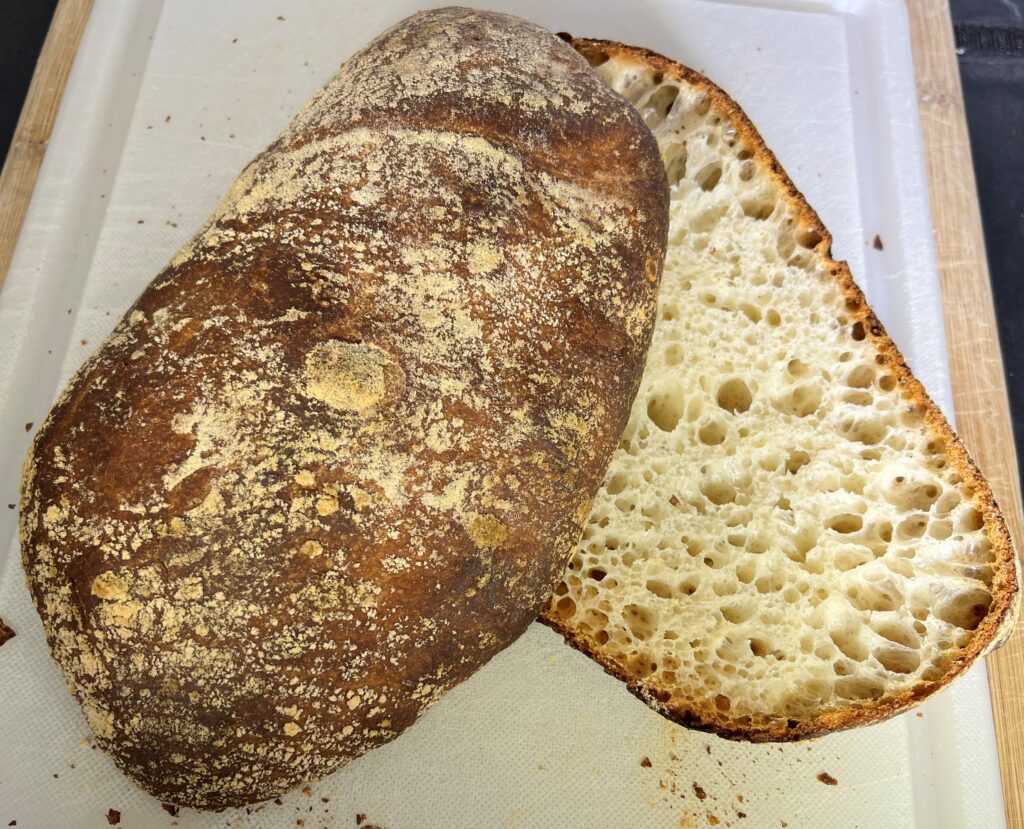
Pan de Cristal is a traditional loaf from Catalonia which is like an extremely light version of ciabatta. It is made with a very unusual 100% hydration dough (i.e. equal weights of bread flour and water) which produces a good result from a proper technique. Gluten naturally wants to align into the strands which are necessary for good bread, and in a wet dough the gluten can move easily and all it takes is a little handling to help the gluten arrange itself. (This is in contrast with lower hydration doughs which need to be kneaded for significant amounts of time to help the gluten arrange itself.)
This is based on a recipe published by King Arthur Flour. It makes 4 loaves of about 8 oz. each. Here is a summary of the preparation and baking schedule, which takes about 6 hours in total.
| No. | Step | Time | Cum |
| 1 | Mix the dough | 0:05 | 0:05 |
| 2 | Rest | 0:20 | 0:25 |
| 3 | Bowl Fold | 0:01 | 0:26 |
| 4 | Rest | 0:20 | 0:46 |
| 5 | Coil Fold No. 1 | 0:01 | 0:47 |
| 6 | Rest | 0:20 | 1:07 |
| 7 | Coil Fold No. 2 | 0:01 | 1:08 |
| 8 | Rest | 0:20 | 1:28 |
| 9 | Coil Fold No. 3 | 0:01 | 1:29 |
| 10 | Rest | 0:20 | 1:49 |
| 11 | Coil Fold No. 4 | 0:01 | 1:50 |
| 12 | Fermentation | 1:20 | 3:10 |
| 13 | Divide into 4 loaves | 0:05 | 3:15 |
| 14 | Proofing | 2:00 | 5:15 |
| 15 | Bake first 2 loaves | 0:28 | 5:43 |
| 16 | Bake second 2 loaves | 0:28 | 6:11 |
I made this using 100% bread flour, per their recipe. I am thinking next of experimenting with a 50/50 mixture of KFA high gluten flour and Flourish high fiber flour to see if that will produce similar results, but with the benefit of more fiber and a lower glycemic load.
500 g. bread flour
500 g. water
2.5 g. instant yeast
10 g. salt
1 Tbs. olive oil (for greasing the pan)
In a medium bowl, mix together the flour, water, yeast and salt with a dough hook to form a very wet dough with a consistency similar to pancake batter.
Grease an 11 x 7 inch baking pan with the olive oil.
Pour the dough into the pan and cover it. Allow it to rest for 20 minutes.
With wet hands, perform a “bowl fold”, meaning going around the perimeter of the pan and grabbing the dough, lifting it, and folding it into the center. Even after this minimal amount of resting and manipulation, the dough will be noticeably stronger and less like a batter.
Cover and allow it to rest for another 20 minutes.
With wet hands, perform the first “coil fold”, meaning lifting the dough from the center of the pan, stretching it, and then folding it over itself, and putting it back in the pan.
Cover and allow it to rest for another 20 minutes.
With wet hands, perform the second “coil fold”.
Cover and allow it to rest for another 20 minutes.
With wet hands, perform the third “coil fold”.
Cover and allow it to rest for another 20 minutes.
With wet hands, perform the fourth and last “coil fold”.
Cover and allow to ferment for 80 minutes.
Heavily flour the top of the pan and a work surface. Loosen the dough around the edges of the pan and invert it on the work surface. With a bench knife, cut it into 4 pieces, trying the handle the dough as gently as possible so that it is not degassed. Put two of the pieces on a sheet of baking parchment, well separated, and then put the other two pieces on a second sheet of baking parchment. Sprinkle some more flour on the surface of the 4 pieces.
Allow the dough pieces to proof untouched for two hours. The dough pieces should have noticeable bubbles.
After one hour prepare the oven. Put a baking steel or stone in the lower third of the oven and a rack in the upper third. Preheat the oven to 475 degrees.
When ready to bake, use a peel to put one of the sheets of baking parchment with two pieces of dough on the baking steel and bake for 15 minutes. Then move each of the two loaves to the upper rack without the baking parchment and bake them for another 13 to 15 minutes. Remove the first two doughs to cool on a rack.
Repeat with the other two loaves. Cool the breads fully before slicing.

